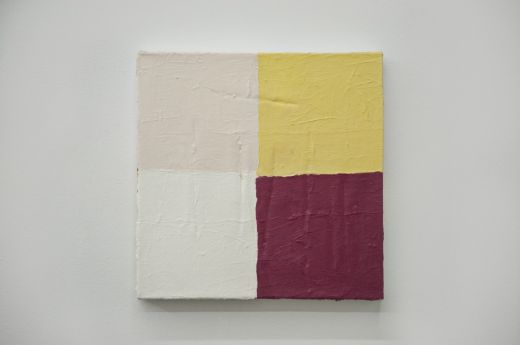Julia Berkman: Edge of Sunshine
Marcos Valella

Julia Berkman, "Endpoint," 2012, acrylic & oil on canvas. Courtesy of the Artist and Fredric Snitzer Gallery.
They hang quietly and unassuming and you quickly realize they will never reach the absolute; the paintings fall short or would fall short if they were developed to play and win the Abstract Expressionist game. She applies conventional AbEx painting ideas such as investigating the boundaries between planes, points of transition from the interior to its contour, defining axes and isolated components of composition, overlapping compromised inter-planar relationships, tension and consistent negotiation of the space and boundaries. She formulates tropes like subtle color shifts, moments of camouflage, transparencies in paint where the bottom color peers through the top color, two edges of color butted up to create a line, and others more contemporary but still part of the aged system: flawed brushwork and the haphazard application of material. These tricks are repeated and repurposed throughout the paintings to give the illusion of intellectual labor.
This illusion in the paintings is the work, and through this illusion she performs an exit to the game. The basis for this is a very sensitive, refined and assertive gesture. In a simultaneously natural and forced manner, she covers the entire canvas with textural brush marks that look more like the residue of a glue stick than paint. The texture extends itself from the first layer of paint to the surface, as if she puts down the soft crumply texture with every layer of color she applies. This surface acts as a secondary system that parallels the first and is symbiotically bound to it. Both systems entirely depend on each other for survival; without the textural bumpy marks, the painting would conform to basic color field, and without the simple linear rectangular composition of color, there would be nothing for the texture to navigate through.
That the paintings can play within the game and exit at anytime is the brilliance in the work. But there are moments of doubt, places where the structure breaks down. In “Endpoint” (2012) there are linear crevices throughout the surface as if a large amount of paint caved in on itself. “Pearl” (2012) is basically a white monochrome with not enough color peering through to the surface from underneath, and “Patch” (2012) is completely out of place. Not only are its sides purposely painted, it is the only painting that does not use a symmetrical composition, and has an extra piece of canvas attached to the surface. These instances disrupt the symbiosis between the paint and the surface, but they do not sabotage it. Rather, they act as a placeholder that will be replaced later with yet another direction.









